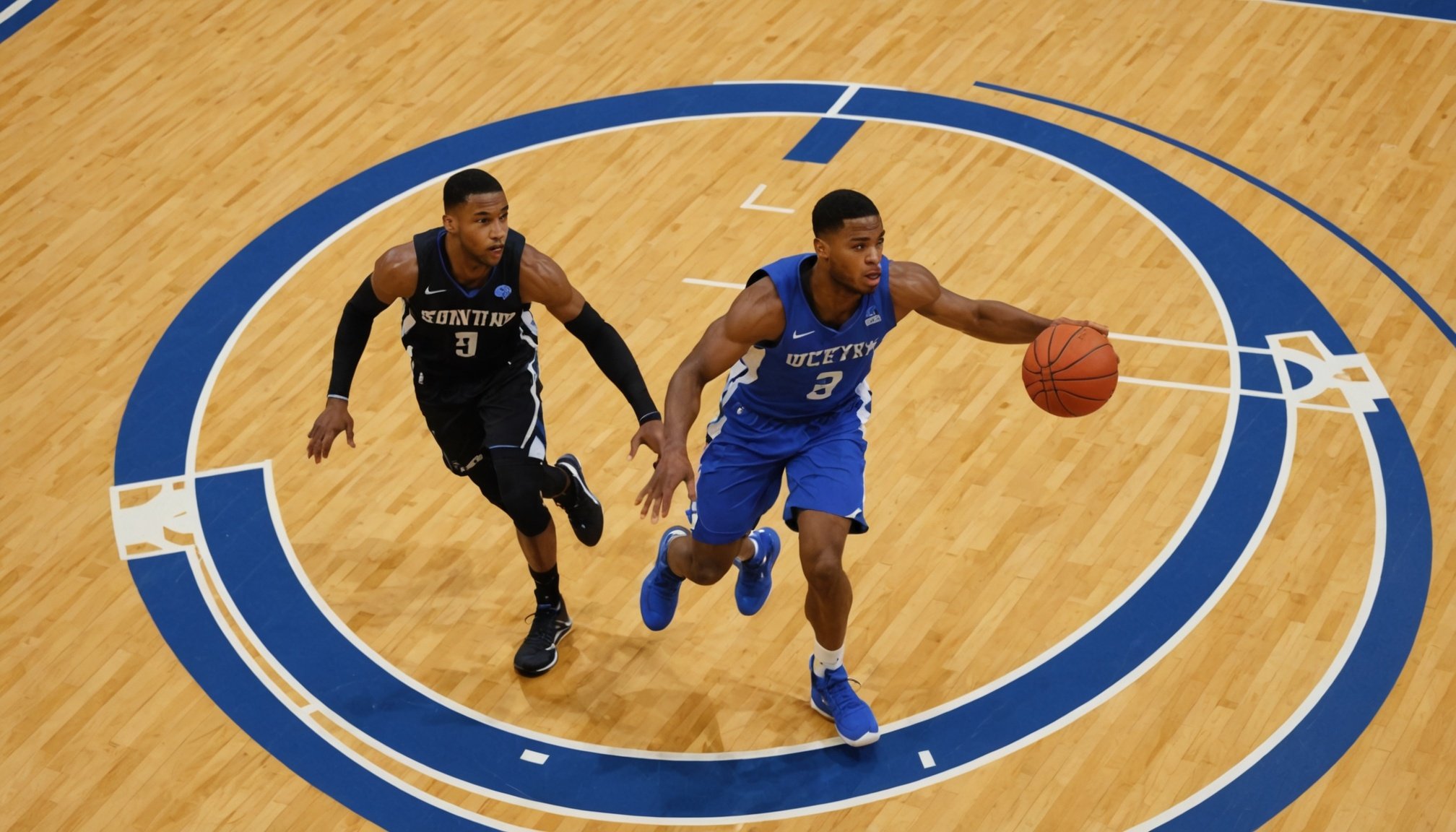Understanding Court Vision in Fast-Break Situations
Court vision is an essential skill in basketball, particularly during fast-break situations. It refers to a player’s ability to assess the entire basketball court, recognising opportunities and threats. This competence allows a player to make swift, effective decisions. In the chaotic nature of a fast-break, players with excellent court vision excel at evaluating the positions of teammates and opponents, ensuring they make the most advantageous plays.
Fast-break techniques are integral to exploiting court vision. A player must swiftly dribble or pass the ball, aiming to keep the opposition off balance. This requires quick and accurate decision-making. Players who lack court vision may miss potential scoring opportunities or make poor decisions that result in turnovers.
Also to discover : Mastering game-time choices: essential tactics for elevating uk basketball players” decision-making skills
Several notable basketball players are praised for their exceptional court vision. Jason Kidd, for instance, was renowned for his ability to see plays develop and make pinpoint passes. Similarly, Magic Johnson’s ability to anticipate movements and create scoring opportunities for his teammates highlighted his superior court vision.
In conclusion, court vision in fast-break scenarios is crucial for effective decision-making. It enables players to swiftly evaluate and utilise available options, putting their teams in a strong position to score.
In the same genre : Accelerate your game: effective techniques for uk basketball athletes to boost speed and reflexes in defensive situations
Practical Strategies to Improve Fast-Break Skills
Enhancing your fast-break strategies involves a focus on essential aspects that contribute to a seamless play. At its core, a successful fast break is all about speed and precision. It requires nimble transitions from defence to offence, effectively utilising every player on the court.
Basketball drills are critical for refining these skills. Incorporating practice drills that simulate game conditions helps players react instinctively under pressure. Key drills might include dribbling exercises, sprints, and passing under pressure. These activities enhance both speed and ball control, which are vital in executing a fast break.
Communication among teammates plays an equally important role. As players transition, clear verbal signals ensure that everyone knows where to be and what their role is. For instance, calling out screens or alerting teammates about open lanes can significantly enhance the fluidity and success of a fast break.
To maintain speed and control, players should focus on maintaining an upright posture, keeping the head up to survey the court, and reducing unnecessary movements. Through strategic practice and drills, and by cultivating communication, teams can enhance their ability to execute fast breaks with precision.
Drills to Enhance Fast-Break Techniques
Fast-break techniques in basketball depend heavily on training exercises and skill development. By focusing on specific drills, players can drastically improve their ability to execute successful fast-breaks.
Drill 1: Three-on-Two Fast-Break Simulation
This basketball drill involves three offensive players attacking against two defenders, fostering quick decision-making and teamwork. Athletes should prioritise spacing, movement, and communication. The objective is to hone coordination and speed in transition, while coaches should emphasise efficient passing and shooting under pressure.
Drill 2: Full-Court Passing Drills
Aimed at enhancing skill development in fast-paced situations, this drill involves players making quick outlet passes from defence to offence. Focus is on accuracy and control over long distances. Athletes should be aware of decision-making and anticipating teammates’ movements. Coaches are encouraged to stress the importance of keeping the ball moving rapidly up the court, minimising dribbles to maintain a fast tempo.
Drill 3: Decision-Making Under Pressure Exercises
These training exercises simulate high-pressure scenarios to improve players’ composure and strategic thinking. The emphasis is on identifying opportunities swiftly and reacting decisively. Key focus areas are reading the defence and recognising when to shoot or pass. Coaches should guide athletes to stay calm and collected, fostering a mindset of quick yet thoughtful responses.
Insights from Coaches and Basketball Experts
Basketball is a dynamic and fast-paced game which requires players to be adaptable, especially during fast breaks. UK basketball coaches offer invaluable coaching insights that emphasize speed and strategy to exploit defensive mismatches effectively. Perhaps one of the most essential aspects of fast breaks is ensuring that the team is mentally prepared to transition swiftly from defence to offense.
A common mistake players make during fast breaks is failing to maintain sufficient spacing. This often leads to clogged lanes and unnecessary turnovers. Coaches advise maintaining clear communication and positioning to optimize scoring opportunities. Expert advice stresses that players must remain aware of their surroundings and the positions of their teammates at all times.
Another critical component highlighted in basketball training is the mental preparation required for successfully executing fast breaks. Coaches encourage players to visualise potential scenarios and outcomes to better anticipate their opponents’ moves. This mental clarity allows them to make split-second decisions more effectively, increasing the probability of success.
- Avoid clutter by ensuring proper spacing
- Maintain clear communication
- Focus on anticipation and decision-making
Basketball experts assert that developing these skills not only enhances individual performance during fast breaks but also elevates the team’s overall game execution.
Analyzing Successful Fast-Break Examples in UK Basketball
In UK basketball, successful fast breaks have often made the difference between winning and losing. Through a detailed analysis of some notable case studies, we can glean insights into the dynamics of these lightning-fast plays. Take, for instance, the iconic 2014 game where the Manchester Eagles clinched victory. This classic moment highlighted fast-break prowess through impeccable teamwork and player analysis.
Certain players, such as Lydia Charles from the Liverpool Lions, exemplify fast-break excellence with their ability to read the court swiftly and make decisive passes. Using Lydia as an example, we can explore how anticipation and awareness are integral to execution. A detailed breakdown of her movements during a game reveals her instinctive acceleration as soon as her team gains possession, blending speed with foresight.
Moreover, teams like the Nottingham Terriers have crafted their strategy around mastering these fast-breaks. Their ability to transition defense into offense is unrivaled, making them a formidable opponent. Lessons learned from these successes underline the importance of communication, conditioning, and timely positioning in practice.
Adopting these techniques can transform any team’s approach to fast-breaks, proving that with the right strategy, even the swiftest plays can be harnessed effectively.
Video Tutorials and Additional Resources
Delving into fast-break techniques can be greatly enhanced by utilizing video tutorials. These resources offer visual cues and step-by-step demonstrations, making complex strategies more accessible. For those new to these techniques or looking to refine their skills, videos serve as an effective tool for visual learning. Seeing the moves executed in real-time can improve comprehension and retention, enabling players to replicate these strategies in gameplay.
Numerous training resources are available online, providing a structured approach to mastering fast-break strategies. Websites and platforms dedicated to sports education often host a variety of tutorials, breaking down tactics into manageable lessons. Many of these also feature interactive elements or quizzes, reinforcing the skills learned through videos.
The importance of visual learning cannot be overstated in the context of mastering fast-break strategies. Watching experienced players and coaches demonstrate techniques allows learners to catch nuances in movement and timing that might be missed through text alone. This bridge between theory and practice is crucial for effective skill development.
For those seeking additional online resources, look for platforms that offer comprehensive libraries of tutorials, expert advice, and community forums where learners can share experiences and tips. Staying engaged with these tools promotes continuous improvement and fosters a deeper understanding of fast-break techniques.











